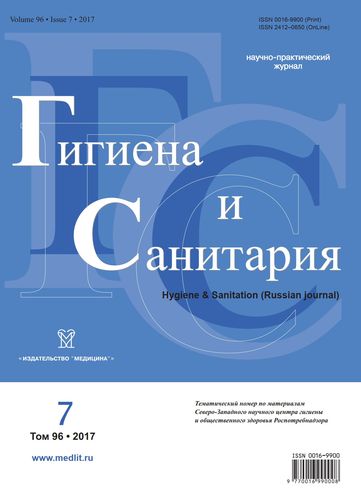Experimental substantiation of the hygienic assessment method of the geotubing of deposits from urban sewage treatment facilities
- Authors: Magomedov K.K.1, Fridman K.B.2, Belkin A.S.1, Noskov S.N.1
-
Affiliations:
- North-Western State Medical University named after I.I. Mechnikov
- North-West Public Health Research Center
- Issue: Vol 96, No 7 (2017)
- Pages: 623-626
- Section: HYGIENE OF THE ENVIRONMENT AND POPULATION HEALTH
- Published: 15.07.2017
- URL: https://ruspoj.com/0016-9900/article/view/638418
- DOI: https://doi.org/10.47470/0016-9900-2017-96-7-623-626
- ID: 638418
Cite item
Full Text
Abstract
Every day in the city of St. Petersburg there is formed more than 10,000 m3 of sewage sludge. The main mass of deposits is stored at the landfill for storing waste with an area of up to 150 hectares. Toxic substances and pathogens contained in sediments can penetrate into the environment stipulating the significant pollution of the environment. In the arsenal of technologists dealing with the problem of sewage sludge disposal, there are numerous approaches and solutions, for instance: drying sludge, incineration, composting, vermicomposting, eco-concrete fixation. However, tried everything methodological approaches have not found their applications because of the impossibility of decrease in toxicity due to the presence of substances in the resulting substance of 1st and 2nd classes of danger, having a translocation mechanism of transition in plants. And, nevertheless, the problem of sewage sludge cannot be solved by used approaches because of the high toxicity caused by the presence of substances of the 1st and 2nd hazard classes in the obtained substance, for which the translocation mechanism of environmental contamination is characteristic. The aim of our work is the substantiation of the hygienic safety of the utilization of products obtained by geotube technology from deposits at the Northern Station for aeration «Vodokanal-SPb» in road construction. As the object of research there was selected the complex of sludge lagoons of the Northern Station for aeration «Vodokanal-SPb» located in the village of Novosilky. Sanitary-chemical, toxicological, parasitological, bacteriological, radiological. It is possible to observe the binding of ionic forms of ecotoxicants, transition of them to a bound state, which provides for the environmental safety. Helminthological and bacteriological studies show the epidemic safety of the product obtained by geotubing. Geotube technology seems to be the most promising in the treatment of accumulated sludge beds on sewage sludge.
Keywords
About the authors
Khamzat K. Magomedov
North-Western State Medical University named after I.I. Mechnikov
Author for correspondence.
Email: xamzat1985@mail.ru
ORCID iD: 0000-0002-1521-551X
Assistant at the Department of Communal Hygiene of the North-Western State Medical University named after I.I. Mechnikov, Saint-Petersburg, 195067, Russian Federation.
e-mail: xamzat1985@mail.ru
Russian FederationK. B. Fridman
North-West Public Health Research Center
Email: noemail@neicon.ru
ORCID iD: 0000-0001-7189-0141
Russian Federation
A. S. Belkin
North-Western State Medical University named after I.I. Mechnikov
Email: noemail@neicon.ru
ORCID iD: 0000-0001-9258-3888
Russian Federation
S. N. Noskov
North-Western State Medical University named after I.I. Mechnikov
Email: noemail@neicon.ru
ORCID iD: 0000-0001-7971-4062
Russian Federation
References
- Karmazinov F.V., Probirskiy M.D., Vasil’ev B.V. The experience of Vodokanal of St. Petersburg on processing and utilization of precipitation. Vodosnabzhenie i sanitarnaya tekhnika. 2002; (12): 13–5. (in Russian)
- Rusakov N.V., Rakhmanin Yu.A. Waste, Environment, People. [Otkhody, okruzhayushchaya sreda, chelovek]. Moscow; 2005. (in Russian)
- Gerasimov G.N. BIOLYSIS – a way to reduce the volume of sewage sludge. Vodosnabzhenie i sanitarnaya tekhnika. 2006; (5): 41–4. (in Russian)
- Shcherbo A.P. Waste Management in Populated Areas: Ecological and Hygienic Aspects [Upravlenie otkhodami naselennykh mest: ekologo-gigienicheskie aspekty]. St. Petersburg: SPbMAPO; 2002. (in Russian)
- Agranonik R.Ya. Problems of treatment and utilization of sewage sludge. Vodosnabzhenie i sanitarnaya tekhnika. 1995; (1): 2–3. (in Russian)
- Medvedev A.S., Strizhko B.C. Neutralization of the precipitation of the urban aeration station. Ekologiya i promyshlennost’ Rossii. 2002; (5): 31–4. (in Russian)
- Semenova V.V., Chernova G.I., Vorob’eva L.V. Ecological and hygienic assessment of lignite waste utilization products. Gigiena i sanitariya. 2001; 80(6): 14–6. (in Russian)
- Fridman K.B. Hygiene of water bodies, water supply and public health. In: Baev A.S., Sorokin N.D., eds. Environmental Protection, Nature Management and Environmental Safety in St. Petersburg for 1980–1999 [Okhrana okruzhayushchey sredy, prirodopol’zovanie i obespechenie ekologicheskoy bezopasnosti v Sankt-Peterburge za 1980–1999 gody]. St. Petersburg; 2000. (in Russian)
- Latypova V.Z., Selivanovskaya S.Yu. Sewage sludge as a potential source of genetic hazard. In: Abstracts of the Conference «Issues of Genetic Hazard in the Republic of Tatarstan» [Tezisy dokladov konferentsii «Voprosy geneticheskoy opasnosti v Respublike Tatarstan»]. Kazan’; 1997: 21–2. (in Russian)
- Mirnyy A.N. Criteria for selection of technology for neutralization and processing of solid domestic waste. Chistyy gorod. 1998; (1): 8–15. (in Russian)
- Soil, Production and Consumption Wastes: Problems of Protection and Control. Conference Materials. [Pochva, otkhody proizvodstva i potrebleniya: problemy okhrany i kontrolya. Materialy konferentsii]. Penza; 1996. (in Russian)
- Household-drinking and Waste Water: Problems of Cleaning and Use. Materials of the International Scientific-Practical Conference [Khozyaystvenno-pit’evaya i stochnye vody: problemy ochistki i ispol’zovaniya. Materialy mezhdunarodnoy nauchno-prakticheskoy konferentsii]. Penza; 1996. (in Russian)
- Axley J.H. Criteria and Recommendations for Land Application of Sludge in the North-East. Vol. 851. University Park; 1985.
- Crommentuijn G.H., Van de Plassche E.J., Canton J.H. Guidance on the Derivation of Ecotoxicological Criteria for Serious Soil Contamination in View of the Intervention Value for Soil Clean-up. RIVM Rapport 950011003. Bilthoven; 1994.
- Gubanov L.N., Kotov A.V., Boyarkin D.V. Use of urban sewage sludge in Nizhny Novgorod to improve soil fertility. Ekologicheskie tekhnologii i innovatsii. 2005; (1): 66–9. (in Russian)
- Korotkova N.A. Centralized composting of sewage sludge. Vodosnabzhenie i kanalizatsiya: ekspress-informatsiya. 1990; (14): 1–3. (in Russian)
- Vasil’ev B.V. Treatment and utilization of sewage sludge in St. Petersburg. Vodosnabzhenie i sanitarnaya tekhnika. 2006; (9): 58–62. (in Russian)
Supplementary files









